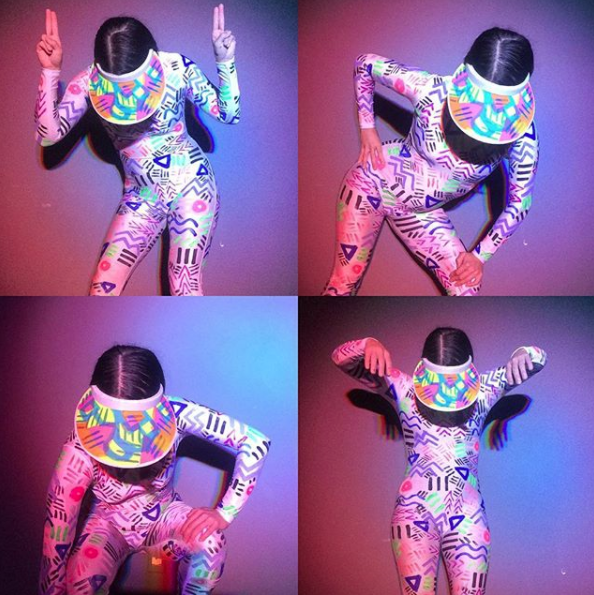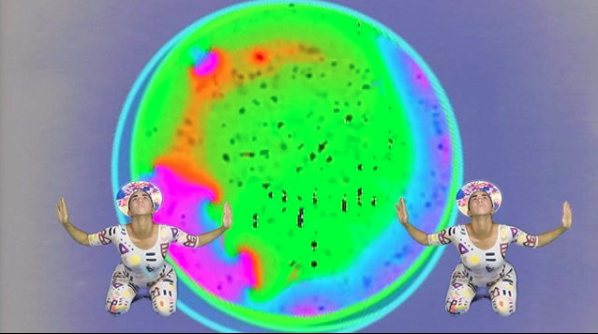Anna Luisa Petrisko of JEEPNEYS
Otherworldly, futuristic, ancestrally familiar, avant-garde. It’s hard to find words that fully grasp the experience that is JEEPNEYS, a name once used interchangeably for multidisciplinary artist Anna Luisa Petrisko and more recently expanded to include research-based collaborative works.
Through music, movement, video, sculpture, and costume (often times all at once) JEEPNEYS creates immersive works that connect both the deep future and the deep past. Or as explained in an artist statement, JEEPNEYS “investigates the complexities of colonized identity and encompasses a multitude of experience of time, space, and self.” Central to these investigations is a focus on the body. While past video works and performances have experimented with various presentations of the body in space and time, JEEPNEYS’ most recent work exploring Body as Ship positions the dressed body as a vehicle for healing and a bridge between pre-colonial ancestry and alternative future(s). “I always spiritually think of the body as a spaceship,” she explains. “Through meditation or through whatever spiritual practice you do, you can communicate with your ancestors, you can travel to the future, you can travel to the past through dream work or through visioning or manifestation.”
After years of playing in feminist punk bands, Petrisko formed JEEPNEYS as a solo project and began exploring her cultural background. “I started doing a lot of research about indigenous Filipino, pre-colonial Filipino practices, spirituality, design and that’s kind of where JEEPNEYS took me,” she says. Eventually, she started to develop a series of bodysuits that she refers to on her site as “re-indigenized alien skin.” Worn by the characters in her work, the bodysuits are white and hand-painted with brightly colored shapes, symbols, and patterns. The suits are often worn with headpieces also adorned with hand-painted detail.
Petrisko says at first she didn’t know why she was focusing on the costumes, “intuitively, I started making these bodysuits and performing with them in these, for lack of a better term, experimental operas… I’m not really a painter, I mean I paint sort of casually, so it was just curious and I didn’t really question it.” Later, during art school critiques and conversations, the pieces began to fall into place as she made connections between full body tattooing practices in pre-colonial Oceania and the Philippines and the bodysuits she was creating. “I feel like my process was very non-linear,” she says, “I work a lot with my intuition and spirituality and my ancestry so to me it was like, oh this is what it’s been about all along and I hadn’t realized it yet.”
Fashion theory, specifically Joanne Entwistle’s work on Fashion and The Fleshy Body posits all bodies as dressed bodies, with clothing, tattooing, and body painting (among other things) ascribing the body with cultural and contextual meaning. JEEPNEYS manages to create worlds where the viewer is taken out of time and place, denied our usual socialized markers to categorize and “make sense.” Somehow this denial of socialized subconscious assumptions puts us rightly in the present, able to experience the disorienting complexity of the work itself. The bodysuit costumes both resist legibility through usual channels of categorization and re-contextualize pre-colonial Filipino practices. They offer an entry point into the possible de-colonized dressed body.
This is a radical accomplishment, especially in relation to the hypervisibility of the body in dance and performance. Petrisko, who has a background in commercial dance, is no stranger to the scrutiny placed on a performer’s body. “A lot of people have opinions about our bodies and whatbodies should do and shouldn't do and look like and not look like,” she says. “It’s a lot to chew on but doing this work has helped me work through it and think about it.” The most recent JEEPNEYS opera, Body Ship addresses this work, as the two sister characters turn their bodies into spaceships in order to travel through time and perform a healing ritual. This opera, as in much of Petrisko’s art, follows a re-indigenization narrative referential to Afrofuturism and Indigenous Futurism. “It is a parallel to what I was doing in my personal life, which was a lot of research about my cultural history,” she explains. “The characters that I was dealing with were also dealing with finding ancestral memory or trying to discover their roots, trying to bridge the deep future and the deep past before colonization.” Exploring the body as ship and travelling through non-linear time also speaks to desiring escape from the socialized constraints of form. “I love working with bodies and I love having a body and I also want to escape my body,” she says, “We live in a world where there is so much projected onto our bodies and sometimes, yeah, I want to move away from the body too.”
What started out as a punk solo music project nearly ten years ago has blossomed into a full multi-media, mutli-dimensional body of work grounded in research and collaboration. After almost a decade, Petrisko admits it may be time to move on. “I feel like JEEPNEYS is kind of coming full circle right now and I’m going to be moving away from the project because I feel like I’ve done the work I’ve needed to do in exploring it.” Regardless of what the future(s) hold, through JEEPNEYS, Petrisko has created examples and possibilities of the de-colonized dressed body.







